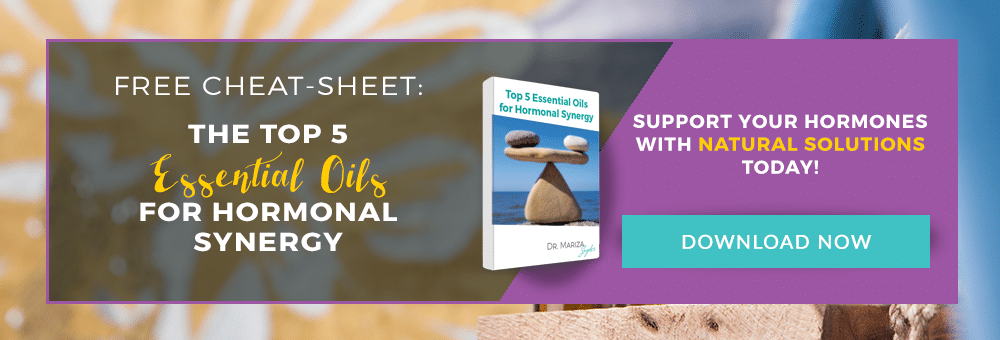
If you’re reading this blog, chances are that you can relate to at least one of these three conditions: PMS, Menopause, and Adrenal Fatigue. Maybe you’ve come to accept that the symptoms you have are just a fact of life and that you just have to live with them. Or hopefully, like me, you’re someone who needs to understand why you feel this way, and you’re going to read everything you can possibly find on the subject until you have a light bulb moment and finally understand how your body works!
Maybe this will be the blog that will help you connect some dots. Then when we can understand how these hormones work, we can find solutions to the conditions that trouble us.
A Lesson in Hormones
I’m sure you already know that Estrogen and Progesterone are a woman’s primary reproductive hormones. Yes, there are a few others involved, but when we’re discussing things like PMS and Menopause, these two are the key players. It’s rather important for these two friends to “play nice” if you will. If one of them becomes a little too bossy and doesn’t share the playground with the other then you end up with hormonal imbalance, leading to things like mood swings, weight gain, water retention, and so on. More about that in a minute. It’s quite possible that if you’re plagued by these symptoms that you are suffering from some sort of hormonal imbalance like Estrogen or Progesterone Dominance. Let’s take a closer look at these two complementary hormones.
Estrogen
Estrogen seems to get all the attention. People make jokes about all the estrogen in a house full of women. And most women assume that when they’re going through menopause that all their symptoms are due to decreasing estrogen. Estrogen is responsible for preparing the lining of the uterus to accept and nourish a growing embryo, it helps slow our rate of bone loss as we age, it protects our cardiovascular health, improves our memory, relieves hot flashes, and improves our sleep health. Estrogen is a good friend to have! However, sometimes she doesn’t play nice, and too much of her can increase our risk of breast and endometrial cancers. In addition, estrogen dominance can make it difficult for progesterone to do its job, leading to things like weight gain, fluid retention, depression, anxiety, headaches, poor blood sugar control, gallbladder disease, and an increased risk of blood clots. Yikes!! There’s more to this list, but you get the idea.
Progesterone
Progesterone doesn’t get quite as much attention. She’s the quiet, calm one. She likes to work quietly behind the scenes. But she’s very important. She’s the balancing act to Estrogen’s type A personality. Once you become pregnant, she’s the one who maintains the safe, cushy lining of the uterus to help that sweet little baby grow. But her job is much bigger than that. Progesterone helps us use fat for energy, helps us maintain normal thyroid function and blood sugar levels as well as being a natural anti-depressant and anxiety reliever. It helps prevent certain types of cancer, helps restore our libido, helps to relax the uterus, and is a natural diuretic which prevents water retention and swelling. Sometimes, when she gets jealous of all the attention Estrogen is getting, she may try to take over, and you end up with too much Progesterone, leading to things like depression or digestive issues.
Stress and the Adrenal Connection
So why do our friend’s Estrogen and Progesterone misbehave? Did they have some big argument that led to the demise of their friendship? Why is one dominating my body right now? The answer may likely have something to do with stress and your adrenal glands. Our adrenal glands are part of the HPAA axis. When our brains perceive a situation as dangerous or stressful, part of your brain, the Hypothalamus tells your adrenal glands to release adrenaline and cortisol into the bloodstream to help your body get through the situation by increasing your heart rate, pumping more oxygenated blood to your muscles, increasing your breathing rate, and tapping your glycogen stores to give you a quick burst of energy. This is all part of your body’s sympathetic nervous system response, also known as your fight-or-flight response. While all of these changes are happening to help you survive the stressful situation, cortisol also triggers a temporary shut down of the reproductive system. It’s not a necessary function for the survival of a life-or-death situation. Normally, when a dangerous situation is over, your body’s sympathetic response returns to baseline and your parasympathetic nervous system (rest and digest) takes over.
Now, let’s think about your daily life for a minute. Think about all the stressors that you have in your life right now. Things like work, illness, travel, marriage, parenthood, finances, and other relationships can be sources of ongoing or chronic stress for us. If you find yourself with very little margin in your life, and you’re always going or battling a stressful issue, you may be dealing with chronic stress. And chronic stress may ultimately be the cause of your hormonal imbalance. Chronic stress suppresses our body’s normal production and circulation of gonadotropins (reproductive hormones), leading to the disruption of normal cycles, PMS symptoms, and even menopausal symptoms. If I could draw you a tree diagram right now, stress would be at the very top of the tree, and all of the branches would show what an incredible cascade of events happens, ultimately leading to hormonal imbalance and unpleasant symptoms at the very bottom.
Essential Oil Support
There are a number of things you can do to help attenuate the effects of stress on your hormones. Maintaining a healthy diet, reducing your toxic load, getting adequate sleep, exercising regularly, and taking time for yourself are all necessary components to supporting and healing a stressed body, but if you want to try something that can immediately alter your current state of stress, essential oils may be your new best friend.
I’m not talking about a quick-fix cure here. Essential oils will not “fix” your hormonal issues, but they will help you cope with and relieve feelings of stress, and they may even help you alleviate some of those pesky symptoms you’re experiencing thanks to stress. There are plenty of research studies showing that inhaling certain essential oils can cause a decrease in circulating cortisol levels, maintain healthy blood pressure levels that are already within the normal range, and help to alleviate sleep issues. Here are a few of my favorite essential oils to help support your body during stress.
Bergamot Essential Oil
Bergamot, latin name Citrus bergamia, is a citrus fruit, and its essential oil is cold pressed from the rind of the fruit. It has a softer citrus aroma combined with an herbaceous aroma. Bergamot is very relaxing, calming and emotionally uplifting, and one of the first oils I turn to when I am feeling anxious or stressed. Thanks to at least one of its main chemical components, linalyl acetate, it is a great choice for easing smooth muscle spasms of the digestive tract and uterus. It blends very well with the other three oils listed below.
Lavender Essential Oil
Lavender, latin name Lavandula angustifolia, is a pretty well-known flower. The essential oil comes from the steam distillation of the flowers. Lavender is widely used in the fragrance industry as well as in bath and beauty products, and even home care products. I personally find pure lavender oil to have a much more pleasing scent than most lavender-scented products, and when I am stressed or anxious it is usually the first essential oil I turn to. It’s sweet, floral, and slightly fruity aroma immediately calms my nerves and takes me to my happy place. In fact, placing a drop in the palm of my hands and then inhaling with my hands cupped over my nose creates a mesmerizing scent that I can’t resist and doesn’t quite have the same effect as when I diffuse it. Lavender oil, like bergamot, also contains a good percentage of the component linalyl acetate and also blends well with the other oils I recommend in this blog.
Frankincense Essential Oil
Frankincense comes in a few different varieties, one of the commonly used ones being Boswellia carterii. All varieties of Frankincense are resins or gums, and the essential oil is a product of the steam distillation of these resins. This essential oil has a resinous, woody, and slightly spicy aroma that is very grounding. It’s great for calming and focusing the mind, addressing head and neck tension, and it blends well with many oils including the other three listed here.
Clary Sage Essential Oil
Clary Sage, latin name Salvia sclarea, is a flowering plant that produces an essential oil that is aromatically sweet, warm, and herbaceous. Like Lavender essential oil, Clary Sage oil contains linalool, and its linalyl acetate concentration is greater than both bergamot and lavender, making it very useful for relieving smooth muscle spasms of the uterus. In addition, its effects are relaxing, uplifting, and calming to the central nervous system.
Try picking two or three of these essential oils and adding them to a roller bottle with your choice of carrier oil and rub onto your pulse points when you need a dose of calm. Or try this diffuser blend:
SOOTHE ME DIFFUSER BLEND
1 drop Frankincense essential oil
2 drops Lavender essential oil
1-2 drop Bergamot essential oil
One of the keys to finding hormonal balance is by reducing your stress. If you take time for yourself and add a few essential oils to your daily routine you’ll be well on your way to feeling like a more relaxed version of you.
What do you think? Are you convinced yet? If you want to set up a personal wellness consultation to discuss your health needs and which oils I recommend, click here: Schedule Your Free Consultation



No comments yet.